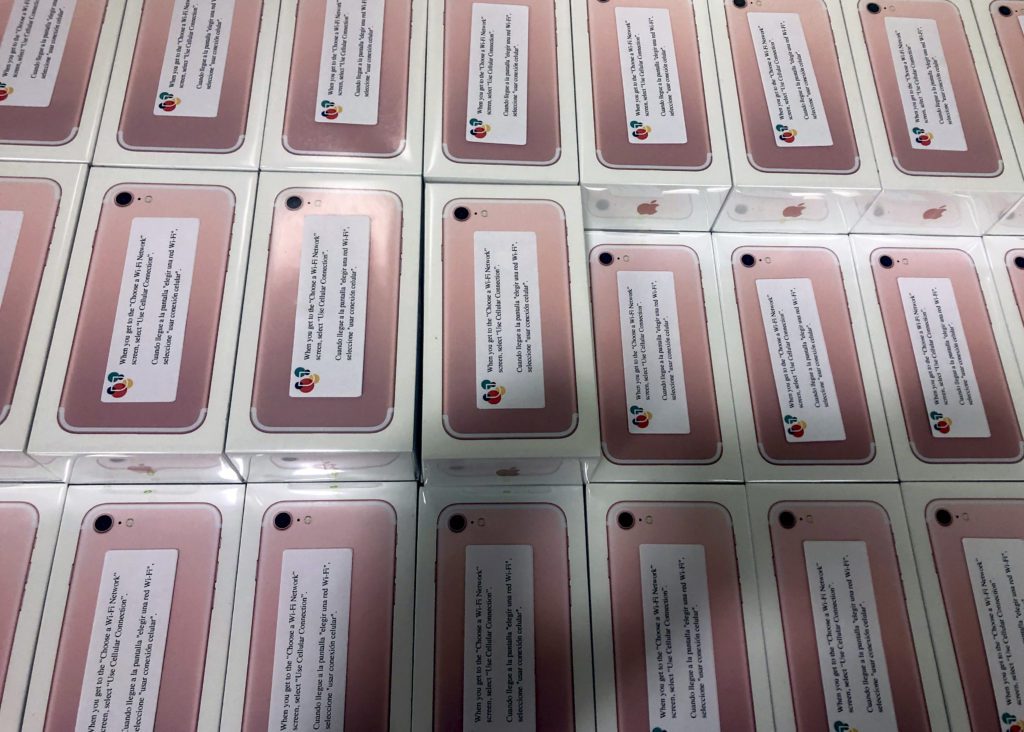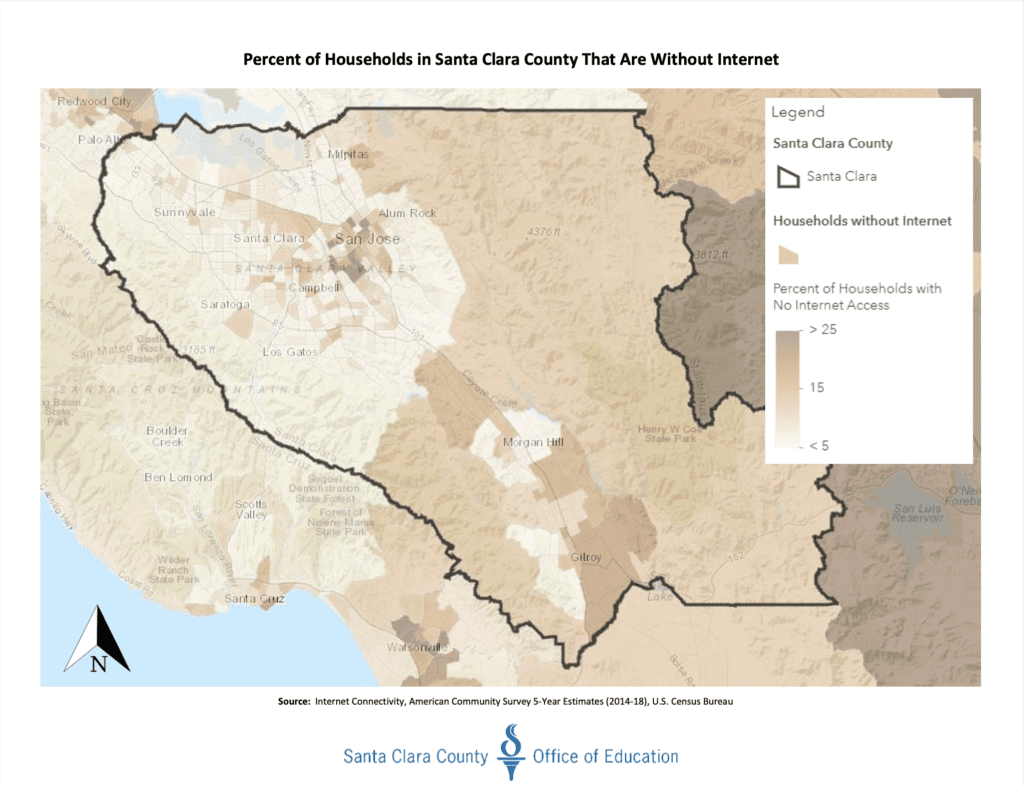Students are resuming in-person instruction this school year, but some will be returning with significantly different experiences from their months of virtual learning.
Erendia Diaz, who has sons in the Alum Rock Union School District and East Side Union School District, experienced this gap firsthand. When her sons switched to virtual learning last year due to the pandemic, they couldn’t rely on the spotty internet service in their home. Diaz’s monthly internet bill cost too much and the service cut out during her sons’ online classes. But she couldn’t switch service providers without paying a penalty.
Both districts later provided Diaz’s sons with a Wi-Fi hotspot and laptop, and she says the coverage is much better.
“Before we got the hotspots, the teacher would be talking online in one of their classes and the internet would pause. They would just see the ‘loading’ circle,” Diaz said in Spanish through a translator. “By the time the internet would kick back in, the teacher would already have gone through a majority of the lesson. Now they’re sitting in classes without an issue.”
San Jose and its school districts, seeing positive results, are ramping up efforts to increase internet access. Mayor Sam Liccardo this month announced the Adobe Foundation granted $250,000 to the San Jose Digital Inclusion Fund, a $24 million effort between the public and private sectors to help close the digital divide.
“The mayor’s goal is for every student, and their families, to have home access to broadband internet—paired with devices and digital literacy skills necessary for online learning and engagement,” Liccardo’s spokeswoman, Rachel Davis, told San José Spotlight. “The pandemic has shown that connectivity is a critical necessity, not a luxury, for all families and students. We cannot leave students behind in today’s digital world.”
Bridging the gap
The Digital Inclusion Fund is part of several efforts the city started to get internet access to underserved communities. In August, the city launched SJ Access in a joint effort with the San Jose Public Library to provide free internet access, computer classes and tech devices, such as internet hotspots, tablets and laptops.
Since August, the library has provided 12,800 free Wi-Fi hotspots to K-12 students in San Jose and 3,000 hotspots to residents. In April, the library also added more rental device options, including 600 Chromebooks and 120 iPads. Devices can be rented from 90 to 120 days.
Residents have checked out about 3,200 devices, said library spokesperson Elizabeth Castañeda.
There is a large digital divide in the region: A quarter of households in Santa Clara County don’t have internet, and many residents can’t afford the high-speed internet necessary to run platforms used for learning such as Zoom.
In San Jose, about 95,000 residents lack access to broadband internet, including 36% of Latino families and 47% of African American families, according to a 2017 study conducted by the city, Stanford University and tech nonprofit Community Connect Labs.
At San Jose Unified School District, the city’s largest district by enrollment, digital inclusion efforts ramped up after the district moved to online learning last year due to the pandemic.
The district purchased approximately 6,000 iPhones to be used as mobile hotspots after looking for—and failing to find—a tech company willing to cover the purchase. The district paid Verizon about $200,000 per month for data plans on the iPhone hotspots during the 2020-21 school year.


San Jose Unified School District also received more than 1,400 hotspots serviced by AT&T from SJ Access and the Santa Clara County Office of Education.
“One of the drawbacks to hotspots is they are very dependent on the cell service in the area,” said Ben Spielberg, the district’s spokesman. “While our technology team did a great job troubleshooting connectivity issues with all of our families, ultimately, if you want to have digital equity, what you need to do is make the internet a public utility.”
Equal access
In the East Side Union High School District, which contains some of the city’s most low-income students, voters approved a $117 million bond in 2014 to provide modern technology to students and teachers, classrooms, security, distance learning and innovation. A total of $8 million is targeted toward Wi-Fi and connectivity to surrounding neighborhoods.
It’s part of the district’s multi-pronged plan to provide high-speed internet both at home and in the classroom. Right now, three of the district’s high schools provide Wi-Fi access to surrounding neighborhoods. According to Lorena Chavez, an East Side Union trustee and member of the Digital Equity Coalition, the district hopes to push that number to eight by the end of the following year.
“It’s not just the high school students who are benefiting from this, but also students from the feeder schools, it’s the families,” Chavez told San José Spotlight. “Parents who want to log on online to do something like telehealth appointments, you name it. They can do that too. It’s a beautiful thing. It’s access.”
If the community truly wants to bridge the digital divide, she says, there has to be more investment in places like East San Jose, where neighborhoods disproportionately have less access to the internet.
“High-speed internet, and the computer, those are just tools. Those tools are equal to having a seat in the classroom,” Chavez said. “This is the baseline. Unfortunately, for too long, our students haven’t had the basic tools so that they could engage in learning.”


With SJUSD returning to in-person learning in August, the hotspot program’s remaining funds will be redirected to other school-related efforts. The district is asking families who rely on the program to go to the San Jose Public Library to obtain hotspots.
But that poses a problem for the hundreds of families who used hotspots during the pandemic. While online learning might be going away, the need for internet access is not.
“Policymakers throughout the country should’ve known this year that there were going to be gaps in learning because there’s no way to make distance learning truly equitable,” Spielberg said. “This program helped, but it also showcased how, in general, we need to solve the resource inequities in society if we want to close opportunity gaps.”
To learn more about the city’s internet connection programs and how to get services, call (408) 716-3811.
Contact Lloyd Alaban at [email protected] or follow @lloydalaban on Twitter.



Leave a Reply
You must be logged in to post a comment.